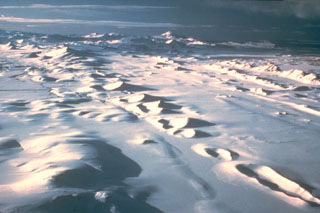Report on Bardarbunga (Iceland) — 26 November-2 December 2014
Smithsonian Institution / US Geological Survey
Weekly Volcanic Activity Report, 26 November-2 December 2014
Managing Editor: Sally Sennert.
Please cite this report as:
Global Volcanism Program, 2014. Report on Bardarbunga (Iceland) (Sennert, S, ed.). Weekly Volcanic Activity Report, 26 November-2 December 2014. Smithsonian Institution and US Geological Survey.
Bardarbunga
Iceland
64.633°N, 17.516°W; summit elev. 2000 m
All times are local (unless otherwise noted)
During 26 November-2 December, IMO maintained Aviation Colour Code Orange due to continued activity at Bárdarbunga’s Holuhraun eruptive fissure. Based on a field report from 25 or 26 November the activity was characterized as pulsating; lava surged from the vent for 2-3 minutes, every 5-10 minutes, causing bulges in the upper parts of the lava channel. Measurements obtained during an overflight on 26 November indicated that the total amount of subsidence of the Bárdarbunga Caldera was about 50 m, with an estimated volume of 1.4 cubic kilometers. The rate of subsidence in the center of the caldera had decreased slowly compared to the first month of the eruption. Observers in Dyngjusandur, NE of the vent, photographed the plume at 1441 on 27 November and indicated that the top of the plume was 3.1 km above Dyngjusandur, and the base of the aerosol-laden lower part of the plume was about 1.4 km above the sand plain. A thermal image from 1 December showed several changes to the lava field: in just over 24 hours a new lava extrusion at the NE margin traveled 450 m; a new flow traveled N, just W of the lava lake; and a new flow was forming S of the lava lake, and then to the E of that flow. The lava field covered just over 75 square kilometers on 1 December.
Geological Summary. The large central volcano of Bárðarbunga lies beneath the NW part of the Vatnajökull icecap, NW of Grímsvötn volcano, and contains a subglacial 700-m-deep caldera. Related fissure systems include the Veidivötn and Trollagigar fissures, which extend about 100 km SW to near Torfajökull volcano and 50 km NE to near Askja volcano, respectively. Voluminous fissure eruptions, including one at Thjorsarhraun, which produced the largest known Holocene lava flow on Earth with a volume of more than 21 km3, have occurred throughout the Holocene into historical time from the Veidivötn fissure system. The last major eruption of Veidivötn, in 1477, also produced a large tephra deposit. The subglacial Loki-Fögrufjöll volcanic system to the SW is also part of the Bárðarbunga volcanic system and contains two subglacial ridges extending from the largely subglacial Hamarinn central volcano; the Loki ridge trends to the NE and the Fögrufjöll ridge to the SW. Jökulhlaups (glacier-outburst floods) from eruptions at Bárðarbunga potentially affect drainages in all directions.

